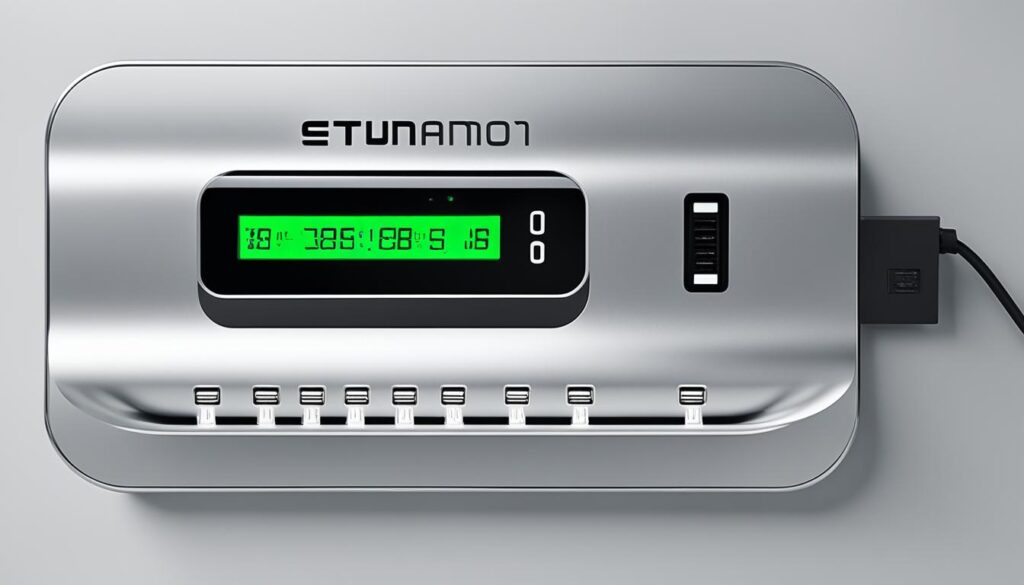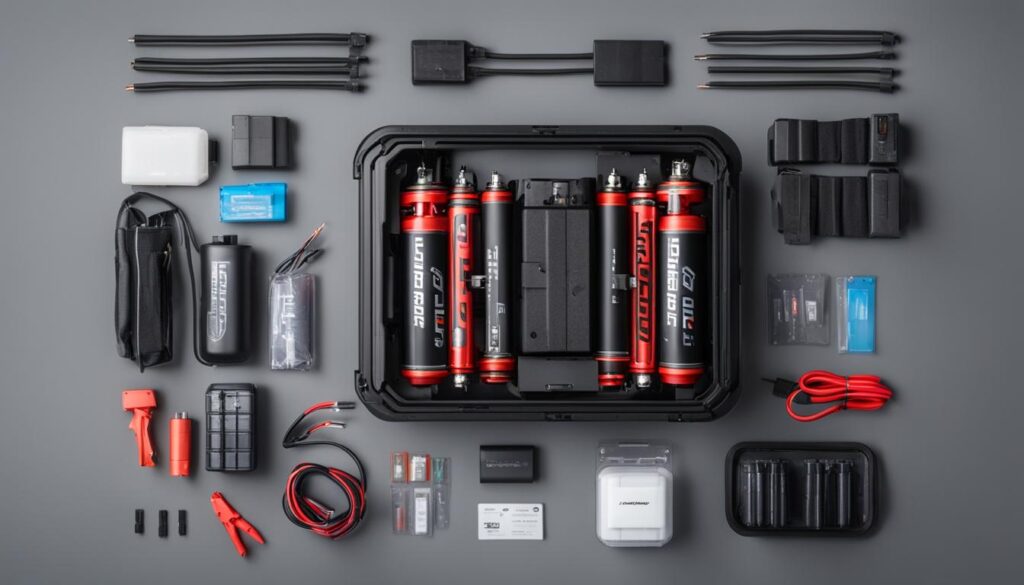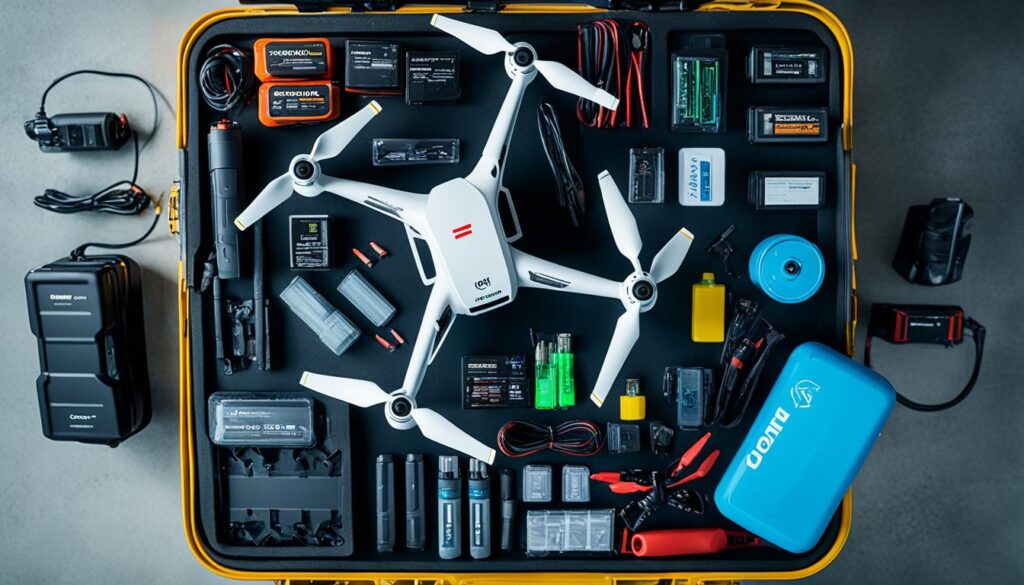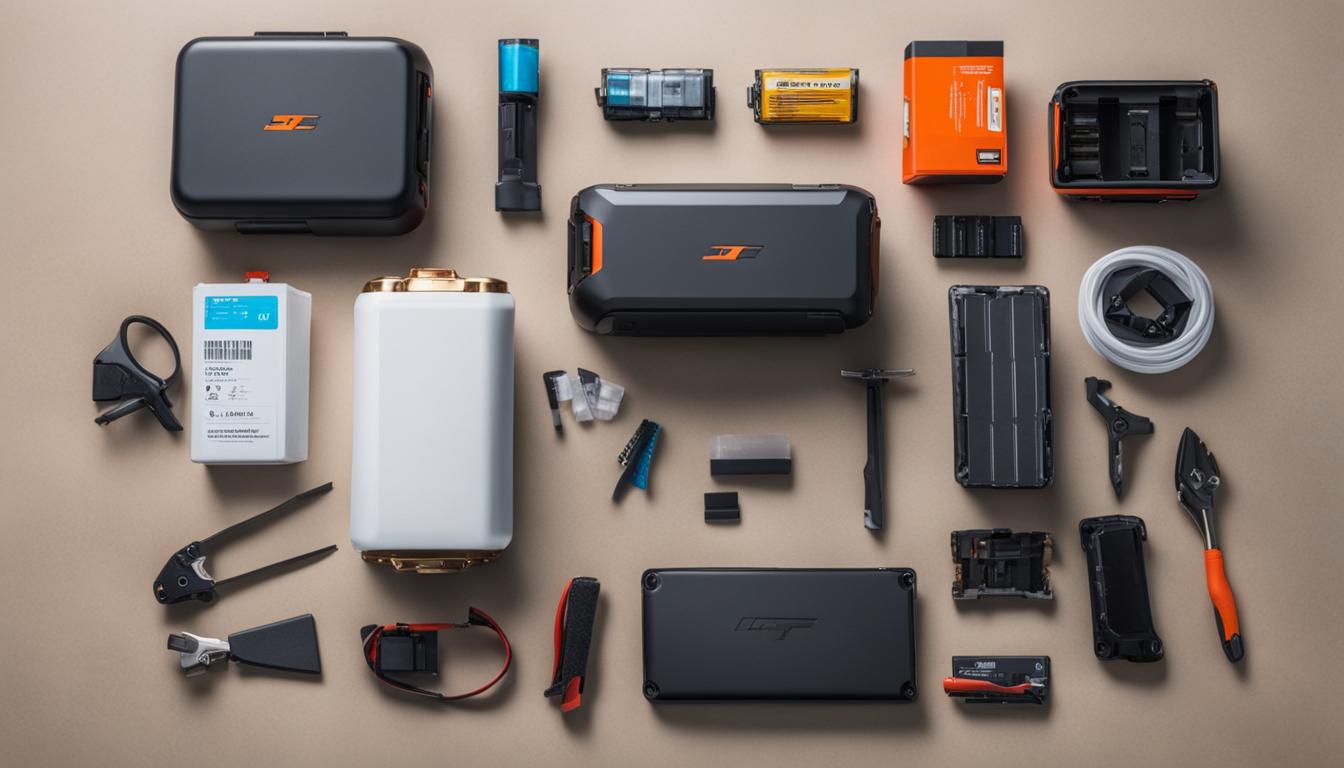Aspiring to achieve greater heights and longer flights with your drone starts with a foundation of comprehensive Battery Care and Maintenance for Longer Flights. The vitality and endurance of your drone’s power source rest in your hands. Proper drone battery care is a crucial element for not only enhancing the flying experience but also for maximizing battery life. Addressing the needs and nuances of your drone’s energy core can significantly influence its operational efficiency and lifespan.
In the realm of drone aviation, every enthusiast or professional understands that battery health is not just about power—it is about the smart and strategic utilization of your resources. Soaring through the skies for extended periods requires a symbiotic relationship between the pilot and their equipment, and a diligent approach to battery maintenance paves the way for this. Stay tuned, as we delve deeper into the art of battery upkeep and grace the skies for longer, uninterrupted adventures.
Understanding LiPo Drone Batteries and Their Care
Lithium Polymer (LiPo) batteries represent a cornerstone of modern drone technology, providing the high power-to-weight ratio essential for efficient flight. As the backbone of drone performance, understanding the care and maintenance of these batteries is paramount for aspiring and veteran drone enthusiasts alike. With proper lithium polymer battery care, drone battery maintenance, and adherence to battery safety precautions, one can ensure optimal performance and longevity of their drone’s power source.

The Chemistry Behind Lithium Polymer Batteries
At the core of a LiPo battery’s functionality is its unique chemistry, which allows for higher energy storage and discharge rates suitable for the demands of drone flight. These batteries are made up of a series of cells that release energy through controlled chemical reactions, requiring meticulous handling and servicing to maintain their integrity and power output.
Role of Battery Management Systems in Drone Operation
The integration of sophisticated Battery Management Systems (BMS) in drone designs ensures that each cell within a LiPo battery operates within safe parameters. This internal computer not only tracks usage but also monitors the health of each cell, making it essential for drone operators to understand BMS indicators to perform timely drone battery maintenance.
Firmware Updates and Its Impact on Battery Performance
Keeping your drone’s firmware up-to-date is a frequently overlooked aspect of lithium polymer battery care. Manufacturers continually release firmware updates that can enhance the efficiency and safety protocols of the BMS. These updates can lead to more accurate battery status readings and longer life spans for your drone’s batteries.
| Battery Maintenance Factor | Significance | Recommended Action |
|---|---|---|
| Storage Charge | Maintaining optimal charge levels prolongs battery life. | Store batteries at 40-60% capacity for best results. |
| Temperature | Extreme temperatures can lead to reduced performance and damage. | Keep batteries in a climate-controlled environment. |
| Cell Health | Regularly exercising the batteries can preserve cell integrity. | Perform routine charge-discharge cycles. |
| Firmware | Updates can improve BMS performance and efficiency. | Check for and install firmware updates regularly. |
Essential Practices for Battery Charging
Protecting the lifespan and efficiency of your drone’s power source hinges on your approach to battery charging. Adhering to specific battery charging tips is not just about sustaining flight times but significantly about maximizing battery life and assuring safety during operation. Below are critical guidelines to follow when charging your drone batteries.
Optimal Charging Temperatures for Prolonged Battery Life
For the best long-term results, it is crucial to charge your batteries within the manufacturer’s recommended temperature range. Typically, room temperature, between 68°F to 72°F (20°C to 22°C), is the sweet spot for charging. Extreme temperatures can dramatically impair a battery’s functionality and stifle its ability to hold a charge. Here’s what you need to know:
- Cold Conditions: Batteries are less efficient when cold and may not charge properly. Warming them to room temperature before charging is essential.
- Hot Environments: A battery that’s too warm can be a safety hazard. Allow it to cool down before initiating a charging cycle.
Monitoring Charging Times and Why It’s Crucial
Charging times are about more than convenience; they’re a matter of battery health and operational safety. Monitoring how long your battery charges not only prevents overcharging but also reduces the risk of overheating – a precursor to potential hazards:
| Type of Battery | Average Charging Time | Post-Charge Voltage | Maintenance Tips |
|---|---|---|---|
| Standard LiPo Drone Battery | Approx. 60–90 mins | 4.2V per cell | Store at 40-50% for optimal longevity |
| High-Capacity Drone Battery | Approx. 120–150 mins | 4.2V per cell | Discharge if not used within 10 days |
As suggested, fully charging a battery is ideal only when imminent usage is planned. Otherwise, store them partially charged to reduce stress and preserve capacity. Mindful monitoring of these aspects builds a regimen that maximizes battery life and ensures the readiness of your gear.

Short-Term vs. Long-Term Battery Storage Strategies
When managing drone battery care, discerning between short-term and long-term storage practices is critical to maintaining battery health and adhering to battery storage guidelines. Failure to distinguish between the appropriate strategies for different durations can lead to reduced performance and premature battery wear.
Short-term storage refers to a time frame of less than 48 hours. During this period, keeping a battery fully charged is not advised, as it can induce stress and potential damage to the cells. For users planning to fly their drones soon, it’s permissible to keep the batteries charged short-term in anticipation of imminent use.
In contrast, long-term storage requires a nuanced approach to prevent the depletion of battery quality. It is detrimental to store batteries at their extremities—either completely empty or fully charged. The optimal charge level for prolonged storage is between 40-50% to safeguard the battery’s integrity. This middle ground helps maintain battery capacity and ensure longevity, even when not actively being used.
Proper storage charge levels are vital for preserving battery health during periods of inactivity. Some smart batteries come equipped with auto-discharge features to self-regulate charge levels to an optimal state for long-term storage, but manual adjustment is a recommended best practice for users of batteries without this feature.
- Review the charge level before storing batteries, adjusting as needed to 40-50%
- Regularly check on the battery’s state of charge if not used frequently
- Implement smart discharge features where available

Following established guidelines for storing drone batteries differentiates the responsible drone owner from the novice one. Aligning with these practices not only maximizes battery life but is also a testament to the diligence and care invested in the maintenance of sophisticated flying equipment.
Practical Battery Storage Guidelines
Ensuring proper drone battery care is not only about charging and usage but also involves safe storage practices. Knowing how to correctly store your drone batteries can significantly contribute to maximizing battery life and maintaining performance. Let’s delve into the best practices for both short-term and long-term drone battery storage.
Methods for Short-term Drone Battery Storage
Short-term storage requires attention to the state of charge (SoC) of your batteries. To avoid potential damages, experts recommend discharging your drone batteries to a SoC of 40-50% if they are not to be used within two days.
Understanding Long-term Storage Needs
For periods of inactivity extending beyond a couple of days, it’s crucial to store batteries at an optimal level. Long-term storage at the correct SoC is essential to prevent the acceleration of self-discharge that could occur if the batteries are left at full capacity or completely drained.
Storage Capacity and State of Charge Explained
The state of charge is a clear indicator of the available energy in a battery and is often expressed as a percentage. Maintaining this state at recommended levels inhibits degradation, aligning with battery storage guidelines to ensure longevity and reliability of the drone batteries.

| Storage Period | Recommended State of Charge | Tips |
|---|---|---|
| 1-2 Days (Short-term) | 40-50% | Discharge if necessary, check temperature before storage |
| 3 Days to Several Months (Long-term) | 40-50% | Store in a cool, dry place away from direct sunlight |
| Extended Storage | 40-50% | Check SoC periodically, recharge to storage level if needed |
Maximizing Battery Life During Flights
For enthusiasts and professionals alike, drone battery maintenance is a critical facet of aerial videography and photography. To safeguard the longevity of your flight sessions and enhance overall performance, certain practices must be followed. Here are some expert tips to help you in maximizing battery life while your drone is soaring through the skies.
- Always start with a fully charged battery to prevent premature flight termination.
- In colder climates, keep the batteries insulated before use to preserve charge capacity.
- Conduct a brief hover after takeoff to allow the battery to reach an optimal operating temperature.
- Regularly perform preflight voltage checks to ensure the battery is in good health.
- Avoid using batteries in a self-discharge state as this can significantly reduce flight time.
One often overlooked aspect of drone operation is managing the battery’s temperature during flights. A table below illustrates the importance of temperature management for a drone’s battery life.
| Temperature Condition | Impact on Battery Performance |
|---|---|
| Cold Environment | Battery drains faster, reduced capacity. |
| Warm-Up Time | Increases efficiency, allows full discharge. |
| Preflight Check | Ensures safety and reliability, prevents in-flight power loss. |
By integrating these tactics into your routine, you can greatly enhance the overall efficiency and lifespan of your drone’s battery. Remember, drone battery maintenance is not simply about prolonging flight times; it’s about maintaining the health and safety of your aerial companion. Follow these guidelines and keep your drone flying high, long, and safe.
Battery Safety Precautions to Preemptively Address Hazards
When handling and maintaining lithium polymer batteries, implementing rigorous battery safety precautions is essential. Proper care can significantly decrease the risk of hazards such as thermal runaway, a condition where increased heat can cause a feedback loop leading to a catastrophic failure. By recognizing common warning signs and enacting preventative measures, users can ensure lithium polymer battery care remains at the forefront of their safety protocols.
Thermal Runaway: Identification and Prevention
Thermal runaway is a phenomenon that begins when a battery cell overheat, leading to a rapid release of energy and potential ignition. To identify the onset of this condition, users should be vigilant for abnormal heat, hissing sounds, or swelling of battery packs. Prevention involves:
- Storing batteries away from direct sunlight and high-temperature environments.
- Avoiding charging or using batteries that display any sign of damage or previous overheating.
- Ensuring the use of proper charging equipment and following manufacturer guidelines.
- Regularly checking and adhering to the battery temperature ranges specified by the manufacturer.
Visual Inspections and Safe Handling of Batteries
Regular visual inspections of batteries are a vital component of lithium polymer battery care. A routine check should look for:
| Inspection Criteria | Description | Action Required |
|---|---|---|
| Physical Deformities | Check for bulges, cracks, or punctures | Isolate and recycle the battery |
| Discoloration | Look for unusual colors or patterns on the battery surface | Stop using the battery immediately |
| Leakage | Identify any signs of leaking electrolyte | Neutralize with sand and properly dispose of the battery |
If damage is detected, the battery should be considered a safety risk. It should be stored in a fireproof container and not used until it can be properly disposed of according to local regulations. Always use protective equipment when handling damaged batteries, and never attempt to disassemble or puncture the battery cell walls.
By adhering to these battery safety precautions, users can enjoy the benefits of their technology while minimizing risk. It’s not only about ensuring an extended lifespan for the batteries but also about guaranteeing peace of mind for the user, knowing that their safety practices are up to par with industry standards.
Battery Care and Maintenance for Longer Flights
Dedicated drone enthusiasts understand that maximizing battery life is not just about the flight—it’s about thorough drone battery care and diligent drone battery maintenance. As we explore the best practices to optimize your drone’s performance, it is the regular cycling of your drone’s batteries through discharging and charging that plays an essential role in their overall health and longevity.
Physical Exercise for Batteries Explained
Akin to exercising muscles to keep them strong, drone batteries benefit from the ‘workouts’ provided by routine cycling. This process involves full discharging, followed by a complete charge, which helps to keep the battery’s cells active and efficient. Such regular cycling can lead to an improvement in endurance during flights, reflecting the importance of a holistic approach to drone battery maintenance.
Pre and Post-Flight Battery Care Tips
Effective battery care involves several steps before and after taking to the skies. Preflight preparation should include a full battery check and charging to ensure readiness, while also conducting a hover test to assess the battery’s performance at the beginning of its discharge cycle. Post-flight, it is generally recommended to recharge your drone’s battery only if another flight is imminent. Otherwise, storing the battery at a 50% charge will enhance its lifespan and maintain a healthy state of readiness for the next adventure.
| Pre-Flight Tips | Post-Flight Recommendations |
|---|---|
| Charge to full capacity | Discharge to 50% if not in immediate use |
| Conduct a hover check | Recharge promptly before the next use |
| Verify battery’s temperature is within operational range | Store at moderate temperatures away from direct sunlight |
\
Drone Battery Maintenance: A DIY Guide for Hobbyists
For drone enthusiasts, drone battery care is not just a routine but an essential practice that goes hand in hand with the enjoyment of flying. Drone battery maintenance extends beyond mere charging and storage; it embodies a comprehensive approach to ensuring optimal performance and longevity of your drone’s powerhouse. Each step, when done correctly, can significantly enhance your drone’s operational efficiency.
Getting started with DIY drone battery maintenance means understanding the basics. Below is a structured guide that every hobbyist can follow:
- Use a smart charger that automatically detects the battery’s current status and adjusts the charge accordingly.
- Ensure that your charging setup is in a cool, dry area away from flammable materials.
- Always store batteries at a 40-50% charge if you do not plan to use them within the next couple of days.
- Maintain a regular firmware update schedule for your drone and batteries to ensure all components are functioning with the latest efficiency enhancements and safety protocols.
Implementing a regular inspection routine is key. Here is a detailed weekly maintenance checklist to follow:
| Checklist Item | Details |
|---|---|
| Visual Inspection | Check for damage like swelling, discoloration, and cracks. |
| Functional Test | Verify that the battery charges and discharges properly. |
| Cleaning | Ensure the battery contacts are clean and free from debris. |
| Firmware Check | Confirm that the latest firmware is installed. |
Remember, a well-maintained drone battery not only assures a longer flight time but also supports the overall health and safety of your drone operation. With the right tools and a proactive approach to drone battery care and maintenance, the skies will be yours to explore for years to come.
Drone Battery Health: Monitoring and Diagnosing Signs of Wear
Meticulous monitoring and maintenance are integral to maximizing battery life and ensuring the seamless operation of your drone. While regular usage naturally results in wear and tear, it is the proactive examination and diagnosis of a drone’s battery that can substantially mitigate premature battery failure. There is a spectrum of diagnostic tools and visual cues that, when employed consistently, serve as an effective defense against the inevitable decline of battery health.
Utilizing Voltage Checks and Capacity Testing
Voltage checks and capacity tests are the bedrock of proper battery maintenance, providing essential insights into the current state of your drone’s power source. By performing regular voltage checks, drone operators are able to discern subtle discrepancies that might suggest cell imbalance or impending failure. Similarly, evaluating the battery’s capacity to hold charge under standard operating conditions can reveal a reduction in efficiency. These indicators are critical for battery charging tips, as they guide proper care and preemptive measures, thus safeguarding against sudden power losses in critical moments.
Recognizing the Warning Signs of Battery Failure
Forewarning signs of battery decline are often visible to the vigilant eye. A clear decrease in flight times, unexpected swelling of the battery pack, and irregularities in voltage readings are common harbingers of battery deterioration. These symptoms underscore the urgency of addressing battery issues before they escalate. Early detection coupled with immediate action not only extends the lifespan of your drone’s battery but also plays a crucial role in maintaining the safety standards of your flight operations. Keeping these factors in check is tantamount to maximizing battery life, ultimately leading to more reliable and enjoyable drone piloting experiences.
FAQ
How does proper battery care impact drone flight time?
Proper battery care significantly extends flight times and preserves the longevity of the battery. By following best practices for charging, storing, and maintaining batteries, you can ensure they perform at their optimal capacity, leading to longer flight durations.
What are the key elements of caring for Lithium Polymer (LiPo) drone batteries?
The key elements include understanding their sensitive chemistry, using a battery management system to monitor cell health, and regularly updating drone firmware for optimal performance. Proper storage, regular cycling through charge and discharge, and maintaining them at ideal temperatures are also integral to LiPo battery care.
How do firmware updates affect drone battery performance?
Firmware updates can enhance battery performance and health by optimizing the internal management systems that monitor usage and cell condition. It’s essential to keep the drone’s firmware up to date to ensure batteries function efficiently and safely.
Why is it important to monitor drone batteries during charging?
Monitoring batteries during charging is crucial to prevent overcharging and reduce the risk of fire or explosion. It ensures that batteries are charged within safe parameters and identifies any potential problems early on.
What is the ideal state of charge for short-term battery storage?
For short-term storage, it is recommended not to leave batteries fully charged for more than 48 hours. Instead, discharging them to 40-50% is ideal to maintain their health and avoid damage.
How should drone batteries be stored long-term?
Long-term storage of drone batteries should be done at a 40-50% charge level to prevent self-discharge and degradation. Avoid storing batteries in a fully charged or completely depleted state.
What is thermal runaway, and how can it be prevented?
Thermal runaway is a dangerous condition where overheating can cause batteries to explode or catch fire. Preventing it involves storing batteries in cooler conditions, avoiding exposure to extreme temperatures, and regularly inspecting for signs of damage or wear.
How does physical exercise benefit drone batteries?
Regular cycling through discharge and charge acts as exercise for batteries, maintaining their health and capacity. This practice helps keep the batteries in good condition and maximizes their lifespan.
Can hobbyists perform drone battery maintenance themselves?
Yes, amateur enthusiasts and hobbyists can perform drone battery maintenance by adhering to structured guidelines for charging, storing, handling, and updating firmware. This maintenance enhances operational efficiency and the health of the battery.
How often should voltage checks and capacity testing be done on drone batteries?
Regular voltage checks and capacity testing should be part of routine maintenance to assure the health of drone batteries. Assessing the battery before each flight can help detect early signs of degradation and extend the overall life of the battery.

Leave a Reply